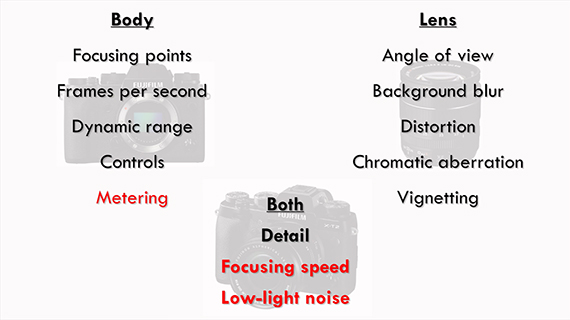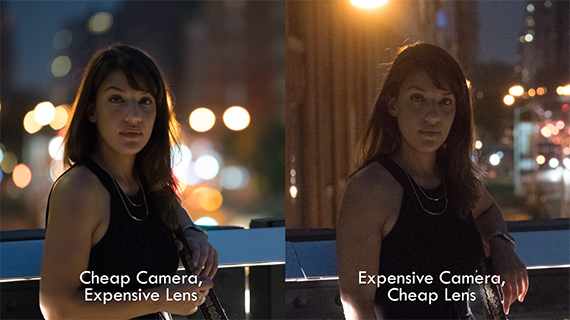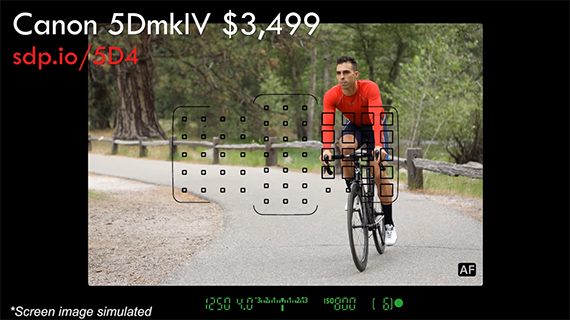When it comes to upgrading camera equipment, deciding whether to splurge on a new camera or a new lens first can be a dilemma. This video tutorial elaborates on the question to help you make the wisest and most economical decision:
Camera Body vs Lens
The camera body controls the focusing points, the continuous shooting speed, dynamic range, shooting controls, metering, among other aspects.
The lens controls the angle of view, the background blur and its quality, the amount of distortion there will be in the image, chromatic aberration, and vignetting.

Upgrading your camera vs. upgrading your lens
Together, your camera and lens determine the sharpness and detail of your images, as well as the amount of noise.
Make Your Decision Based on Your Shooting Style
To a large extent your style of shooting determines which among the above parameters you care for the most. If you’re a portrait photographer you might be most concerned about the number of focusing points, the angle of view, and the background blur. If you’re a wedding photographer, on the other hand, you might consider the metering, the amount of low light noise, and focusing speed, for example.
If you routinely shoot low light images, having a fast lens helps more than having a better camera body. This is a comparison between a combination of a fast lens and cheap camera versus an expensive camera and a cheap lens:

Cheap camera & expensive lens vs. expensive camera & cheap lens
As explained by Tony and Chelsea Northrup, the image on the left was shot with a $400 camera paired with a $1000 lens (100mm f/1.8). Compare that with the image on the right shot with a $2000 camera paired with a $375 lens (100mm f/5.6).
Examples of When to Choose a Camera vs Lens Upgrade
Street photographers often rely on faster focusing. It’s all about the subject, rather than the sharpness. Most street photographers would probably opt for a smaller discreet lens and a compact camera body with better features like a tilt-screen, faster focusing, and a silent shutter. The camera is thus the first priority for a street photographer.
For landscape photographers, a better dynamic range, bigger angle of view, less distortion, less chromatic aberrations, less vignetting and greater amount of detail are must haves. They need a better body as well as a better lens. But if the budget is suitable for only one, then the lens gets first priority.
Sports photography requires better focusing, as well as faster continuous shooting speed and a better buffer. You also need a fast lens and a better focusing system along with a host of other features. Faster continuous shooting with less buffer lag means you get that many more shots to choose from. Fast continuous shooting speed depends on the camera body.

An expensive camera body often has more focusing points.
A better focusing system has more focusing points to choose from and a better way to choose from those focusing points. Thus, when it comes to sports and action photography, the camera body comes first.
All of these considerations aside, when it comes to real advantage, no piece of equipment comes even close to your level of knowledge for improving your photography.
Like This Article?
Don't Miss The Next One!
Join over 100,000 photographers of all experience levels who receive our free photography tips and articles to stay current:






I have a cheap 700D and cheap Tamron lenses. I’m happy with the results. I’m turning them into billboard sized pictures.
Maybe your video need an upgrade! On a, cheap camera (Body from $700. and more) you can have that 11 fps. and a lot more.
But quality lens could make a huge difference.
Hi Rajib,
I quite agree upon the criteria, also supported by Tony + Chelsea Northrup (video), to make your choice somewhat easier …
But then, bringing together a cheap camera + expensive fast lens ($ 1’400) vs expensive camera + cheap lens (2’375) is almost too much !!! I know it’s almost like comparing apples to oranges.
It’s just roughly $ 1’000 more expensive than the cheap camera+expensive lens combo vs the expensive camera+cheap lens combo. However, it’s not such a far throw from doubling what you’re shelling out !!!
Why didn’t you stay in the same price range ??? Impossible you say ?
With this style of comparison all you do is increase the scissoring effect, instead of decreasing it …
What do you have to say to that; and what about the other readers ?